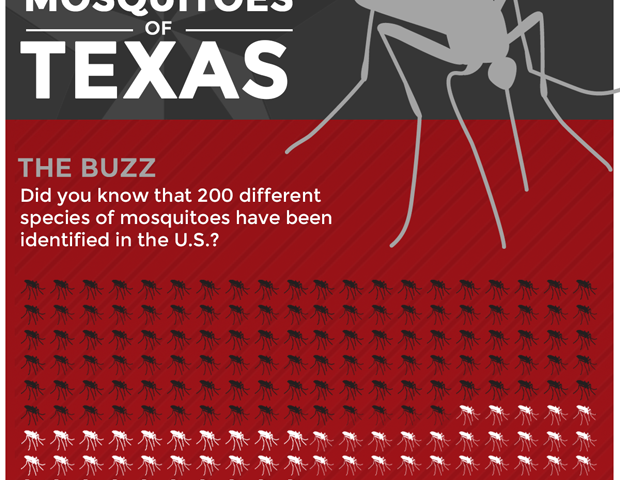
Texas Mosquitoes
Out of the 200 different species of blood suckers found throughout the United States, eighty-five of them call Texas their home. Are they all dangerous? How can you tell them apart? How do they breed? What diseases do they carry? To better answer these questions we gathered and compiled information into one easy to read infographic that covers six of the most common mosquitoes – that are considered to be public health concerns – in the lone star state.

Aedes Albopictus
AKA: Asian Tiger Mosquito
A small, dark mosquito with a white dorsal stripe and banded legs. They are strongly attracted to bite humans, but will feed on cats, dogs and other mammals, as well as birds. They will bite any exposed skin surface. They bite outdoors and indoors, but are usually found outside.
Habitat
Breeds in tree holes , plants, and containers as small as a bottle cap.
Vector
- Zika
- West Nile
- Dengue
- Yellow Fever
- Chikungunya
Active
Bites during the day. Active year-round. Can live for up to three weeks.
Culex Quinquefasciatus
Southern House mosquito
A stealthy medium-sized mosquito with a brown body color. While they prefer to bite birds, they may enter homes at night and bite humans. Known as the main carrier of West Nile virus in the United States.
Habitat
Breeds in polluted waters and containers.
Vector
- Zika
- West Nile
- St. Louis Encephalitis
Active
Bites during the evening, nighttime, and early morning hours.
Culex Tarsalis
Western Encephalitis Mosquito
A black mosquito distinguished by a white band on its proboscis (arrowhead). It is the most important carrier of mosquito-borne viruses in the U.S. They prefer to bite birds and mammals. They are strong flyers and may fly up to 2-10 miles away from their breeding site.
Habitat
Breeds in any standing water, agriculture ditches, and poorly drained pastures.
Vector
- Western Equine Encephalitis
- St. Louis Encephalitis
Active
Most active in the few hours after sunset.
Aedes Sollicitans
Eastern Saltmarsh Mosquito
A medium-sized mosquito recognizable by the golden color of the upper side of the thorax. They are mammalophilic and therefore prefer mammals as hosts but may also prey on birds. In the south the peak amount of adults occurs in the spring and fall.
Habitat
Breeds in salty or brackish water. Prefers the Gulf coast areas.
Vector
- Easter Equine Encephalitis
- Dog Heart worm
Active
Mostly active at twilight but it can be an opportunistic daytime biter.
Psorophora Columbiae
Dark Rice Field Mosquito
A large and dark mosquito with a painful bite. Distinguished by its dark and silver coloring, it prefers livestock and can be found in parts of the county with pastures and livestock. They are excellent flyers that can fly more than 10 miles from their breeding site.
Habitat
Breeds in rice fields and grass fields. Large pastures that flood are prime breeding sites.
Vector
Associated with encephalitis outbreaks.
Active
Anytime during the day when disturbed but prefer the early morning or late afternoon.
Aedes Vexans
Upland Flood Water Mosquito
One of the most widespread mosquitoes in the world and is the #1 pest mosquito in the U.S. It can easily be distinguished by the white bands on the abdomen. During the winter it replaces Aedes Sollicitans as the dominant floodwater species.
Habitat
Breeds in temporary rain-filled pools, roadsides and ditches.
Vector
- Dog Heart worm
Active
It usually bites during night, dusk, or dawn, however, it will also bite during the day in shaded areas.
Mosquitoes can be a pain, so if you have any unwanted pests around your home don’t hesitate to contact us. Our experts can help you through any organic pest control solutions, tree and lawn care for your home, or even humane wildlife removal.




